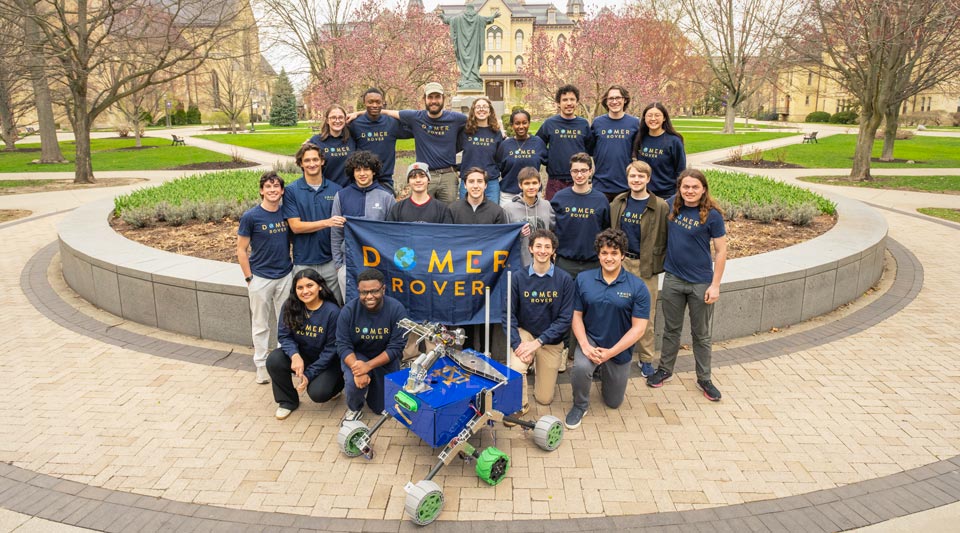Mars is cold, dusty, and full of radiation—too dangerous, too far away, and too expensive for astronauts. But rovers—smart, mobile robots—can move like mini explorers across the Red Planet’s surface, taking pictures, analyzing soil samples, and studying the atmosphere.
Building a rover is no easy task. They require sophisticated equipment to perform multiple challenging missions—often autonomously—while providing their own power and communication systems.
But none of these considerable challenges deterred senior mechanical engineering majors Dorothy Crumlish or her co-founder, fellow mechanical engineer and senior, Griffin Vrdolyak.
“In the fall of 2021—my freshman year—after hearing from friends at other universities about their rover teams, I realized ND didn’t have anything equivalent. While the College of Engineering has many excellent design teams, I saw the Rover Challenge as a particularly valuable robotics and cross-disciplinary engineering opportunity that I thought would be a good addition,” said Crumlish.

The University Rover Challenge (URC) is an international robotics competition held annually by the Mars Society. This competition brings together student teams from universities around the world to design, build, and operate Mars rovers capable of completing a variety of tasks in a simulated Martian environment.
Domer Rover started by focusing on the drivetrain and frame before adding parts for competition tasks. First, they built a remote-control car to learn about steering and controls. Then they made a small PVC version of a suspension system to start experimenting with different designs. That was in spring 2022.
Fast forward to 2024. With reliable club space, a solid budget, and a 30-member multidisciplinary team, the team redesigned and rebuilt their original rover and integrated all the subsystems.

This year’s rover stands about 4 feet high and weighs 80 pounds—about the same as a minifridge. A rocker-boogie suspension system was constructed with carbon fiber tubes and aluminum to enable the rover to tackle Martian terrain.
With a built-in augur, the rover can drill for soil samples then reverse rotate to deposit the soil into containers for comprehensive biochemical assessment. A mechanical arm has a robotic wrist with a gripper mechanism that allows it to open and close drawers and type on a keyboard, tasks required by the competition.
The rover’s navigational system uses 900 MHz to communicate with a self-rotating base station up to 1 km away and 2.4 GHz for short range communications.

“Since we’ve really advanced this year, we’ve had a lot of technical challenges and integration challenges,” said Lydia Chau (ND ’26), Domer Rover project manager and mechanical engineering major. “We’re also using something called ROS 2, a robotic operating system, but there’s not a lot of documentation on it, and most of the professors on campus don’t use it, so we’ve had to teach ourselves.”
Currently, the team is focused on preparing for the University Rover Challenge, held annually at the end of May in the desert of southern Utah.
“It’s pretty amazing. Four years ago, this club didn’t even exist, and now they have a working Mars rover vehicle!” said Domer Rover’s faculty advisor Paul Rumbach, associate teaching professor in aerospace and mechanical engineering. “The vehicle’s maneuverability and autonomous navigation systems have been challenging problems for the students. But after one more semester of adjustments, we hope to be ready for the competition next summer.”
—Karla Cruise, Notre Dame Engineering; Photos by Wes Evard, Notre Dame Engineering
